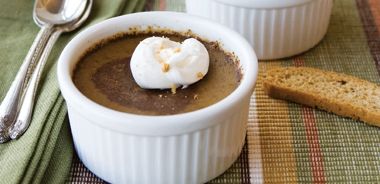Baked Pumpkin Custard

This baked custard is a cross between a pumpkin pie without the pie crust and a crème brûlée without most of the fat. The average baked pumpkin custard or pumpkin crème brûlée has a whopping 20 grams of total fat. My version weighs in with 3.5 g of total fat.
But aside from the fact that this cheater brûlée is a cinch to make, tastes fantastic, and is low in both calories and fat, its real claim to fame is that you have to make it the day before which will make your Thanksgiving Day much less stressful.
You’ll need 4 ramekins for baking the custard. Ramekins are small, usually glazed, ceramic baking dishes that can be purchased at most kitchen stores.
3/4 cup (175 mL) evaporated skim milk
1/2 cup (125 mL) canned pure pumpkin purée
1/4 cup (60 mL) pure maple syrup
2 Tbsp (30 mL) dark brown sugar
1 tsp (5 mL) ground cinnamon
1/8 tsp (.5 mL) ground nutmeg
Pinch of cloves
1/4 tsp (1 mL) pure vanilla extract
2 large eggs
Preheat oven to 350 F (180 C). Put a kettle on to boil with approx. 2 cups (500 mL) water.
Combine evaporated milk, pumpkin, maple syrup, brown sugar, cinnamon, nutmeg, cloves, and vanilla in blender and process till well combined. Add eggs and process until smooth. Set aside so any bubbles on the top of the mixture settle, approximately 5 minutes.
Divide the mixture evenly between 4 – 6 oz (150 g) ramekins. Place ramekins into 8 x 8 in (2 L) baking pan, preferably a metal one; add boiling water to pan so water comes halfway up the sides of ramekins.
Carefully place pan into oven and bake for 35 to 40 minutes or until the custard has set. Remove from pan and let cool on a wire rack. Cover each ramekin and refrigerate overnight. Serve as is or with a dollop of whipped cream on top. Makes 4 servings.
*Use pumpkin purée not pumpkin pie filling. You can either buy it canned or make your own.
Each serving contains (without whipped cream): 173 calories; 8.4 g protein; 3.5 g total fat (1 g sat. fat, 0 g trans fat); 29 g carbohydrates; 8 g fibre; 107.5 mg sodium
For a less sweet version of the Baked Pumpkin Custard, omit the brown sugar.
source: "Thanksgiving Dinner Made Easy", alive #324, October 2009




